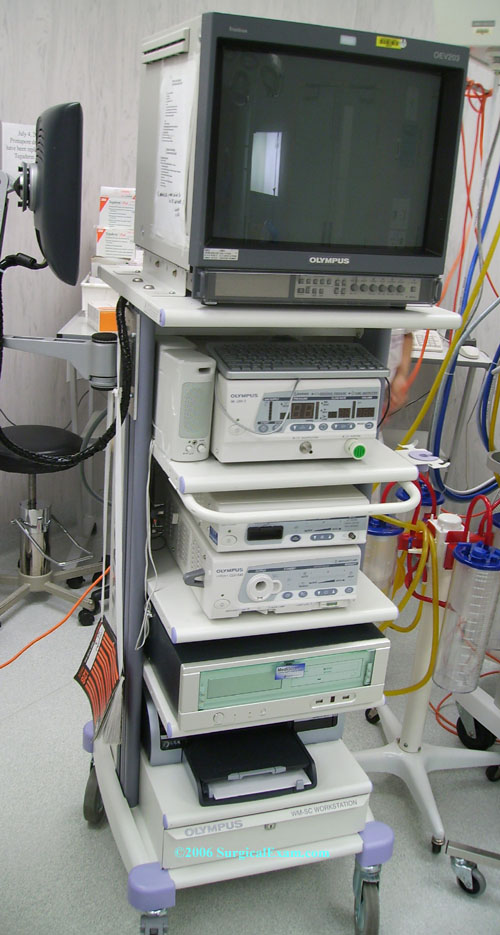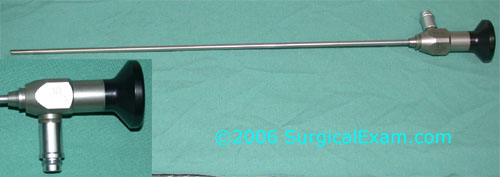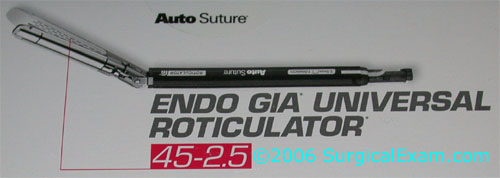Laparoscopic Instruments
Laparoscopic instruments are most commonly designed for use through 10 or 5mm ports although larger and smaller port sizes are available. They are generally long, straight instruments with a handle that may be ratcheted or non-ratcheted. Many of the instruments are designed along the principals of similar instruments used in open surgery.
Take note of the different handles available. Some also have attachments for diathermy. Instruments and handles are often interchangable within a single manufacturers range.
The laparoscopic tower

Although an increasing range is avaliable the key components are a display to view the image, a carbon dioxide insufflator with regulation of intraperitoneal pressure and gas flow rate, a camera connector and a light source. This system also allows photographs to be taken and printed.
Non-toothed graspers


Although more delicate than their toothed counterparts these dissectors may still damage normal tissue and care must always be taken when handling delicate structures.
Toothed graspers

Used for grasping tough tissue particularly if it is to be resected as the teeth may damage normal tissues.
Heavy toothed graspers

This 10mm instrument has long shard teeth that cause significant trauma to tissues. They do provide a firm grasp on most tissues though and are used to retrieve resected specimens such as the gallbladder for removal from the abdomen.
Mixters

Right angled instruments in either 5 or 10mm that are used to pass behind structures.
Maryland's

Slightly curved graspers that can be used to bluntly dissect as well as grasp tissue.
Needle Holders

Various laparoscopic needle holders are available. These have similar grasping surfaces to standard open needle holders. The handle and ratchet are different to those used laparoscopic dissecting forceps and are more ergonomic for the hand and wrist motion involved with laparoscopic suturing.
Stone scoop

This 10mm instrument is useful to pick up and retrieve small dropped items without crushing them such as gallstones during laparoscopic surgery.
Olsen-Reddick

This instrument is used to perform operative cholangiography. A catheter is passed down the centre of the instrument which also has a clamping mechanism to hold the catheter in position within the duct.
Hook

Connected to diathermy this instrument is the main dissector used in laparoscopic surgery
Telescope


Above is a 10mm 30 degree scope to be attached to a camera and flexible fibreoptic lightsource for use during laparoscopy. The second scope is 3mm in diameter.
Sucker-Irrigator

A combination instrument that allows irrigation with fluid and suction to clear the area throught he same instrument.
Laparoscopic ultrasound probe

Used primarily in the staging of upper gastrointestinal malignancies. The combination of exploratory laparoscopy and ultrasound examination of the liver, nodes and other solid organs allows improved patient selection for attempted curative resection.
Disposable Ligature

Disposable Bag

Allows containment of resected tissue to prevent soilage with infection or malignancy thereby preventing contamination and spread.
Disposable Retractor

Passed through a 10mm port this instrument then fans out to provide broad retraction.
Disposable suture

Allows simple single handed placement of sutures and knot tying.
Ultrasonic dissector

Using mechanical energy the ultrasonic dissector coagulates and cuts tissue with excellent haemostatic properties and little dissemination of energy into surrounding tissues.
Disposable tacking device

A spiral tack allows fixation of meshes during laparoscopic hernia repair.
Disposable clip applicator

Available in different sizes these clips are used to uccludestructures such as vessels and bile ducts
Disposable stapler-cutter


This particular device allows different sizes of staple to be fired by the same body of the stapler. Hinged mechanisms or "roticulating" devices improve access and positioning during laparoscopic surgery.